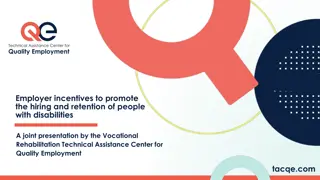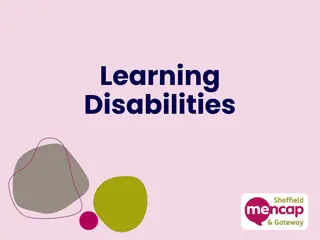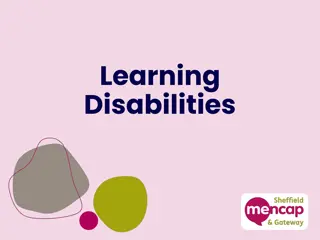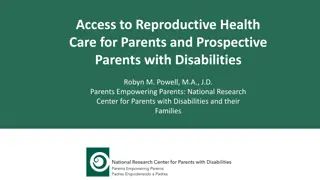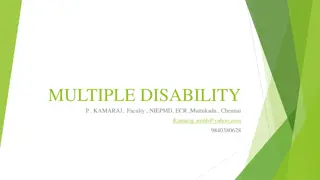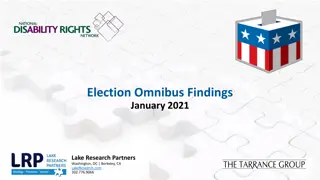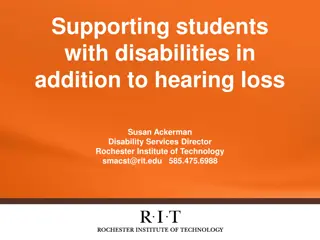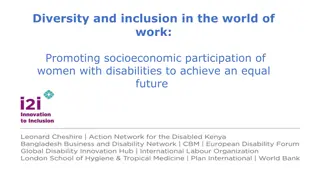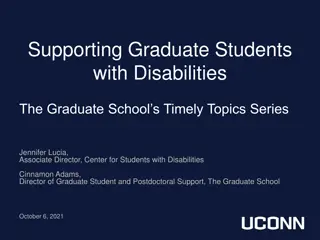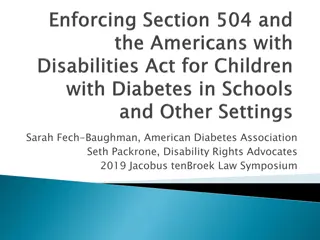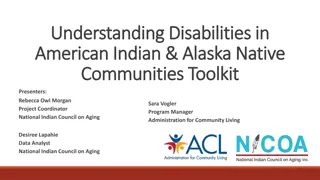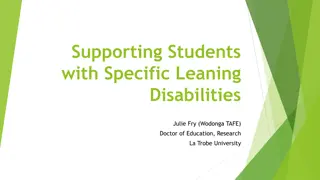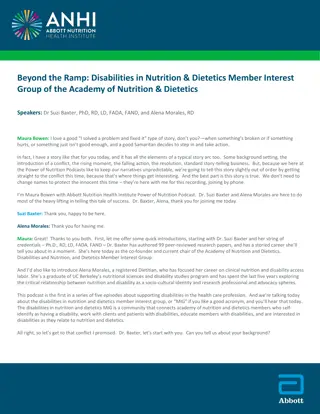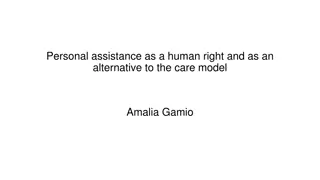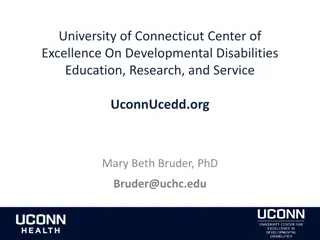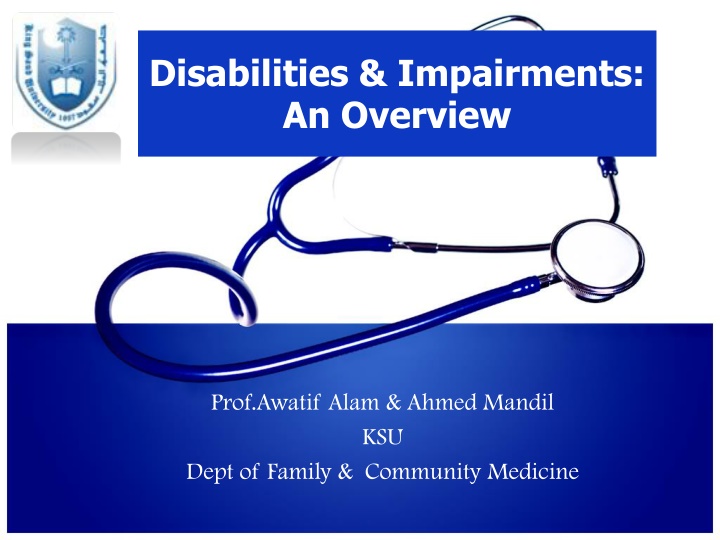
Overview of Disabilities and Impairments in Health Sciences
Explore the concepts of disabilities and impairments in health sciences, covering the types of disabilities, injury prevention principles, etiology, classifications, and the definitions of health and quality of life according to WHO. Learn about the International Classification of Impairments, commonly reported impairment indicators, and how impairments can affect individuals' daily lives. Enhance your understanding of health disorders and the importance of holistic well-being. Join Prof. Awatif Alam and Ahmed Mandil from KSU Dept. of Family & Community Medicine on this enlightening journey.
Download Presentation

Please find below an Image/Link to download the presentation.
The content on the website is provided AS IS for your information and personal use only. It may not be sold, licensed, or shared on other websites without obtaining consent from the author. If you encounter any issues during the download, it is possible that the publisher has removed the file from their server.
You are allowed to download the files provided on this website for personal or commercial use, subject to the condition that they are used lawfully. All files are the property of their respective owners.
The content on the website is provided AS IS for your information and personal use only. It may not be sold, licensed, or shared on other websites without obtaining consent from the author.
E N D
Presentation Transcript
Disabilities & Impairments: An Overview Prof.Awatif Alam & Ahmed Mandil KSU Dept of Family & Community Medicine
Objectives At the end of this lecture, the student should be able to: Describe the concepts of disabilities Understand how people get disabled in their daily lives Describe the different types of disabilities Understand principles of injury prevention and control 19 March, 2025 Disabilities 2
Etiology: Intrinsic vs Extrinsic, Primary vs Secondary. Classification: 1. Physical, 2. Mental, 3. Social.
Definition of Health Health was defined by the WHO as: a state of complete physical, mental and social well being and not merely the absence of disease or infirmity . More recently, the concept has been extended to include health-related quality of life. Today, the International classification of impairments, disabilities and handicaps (ICIDH) provides indicators that allow a more structured approach to health disorders.
Quality of life: In 1993, WHO put forward a definition of quality of life linked to health: The perception by individuals of their position in life, in the context of the culture and value systems in which they live and in relation to their goals, expectations, standards and concerns .
International Classification (ICIDH) : An impairment: any temporary or permanent loss or abnormality of a body structure or function , whether physiological or psychological . An Impairment is a disturbance affecting functions that are essentially : Mental (memory, consciousness) or Sensory, or Internal organs(heart, kidney), The head, The trunk or the limbs..
Commonly reported Impairment indicators General impairment, movement-related impairment Major mental impairment Severe hearing impairment ,blindness, amblyopia Autism, psychosis, cervical column pain Vertebral column pain Unspecified pains, self-perceived chronic health disorders, Do you suffer from a chronic disease? , Musculoskeletal, sensory, digestive , Cardio- pulmonary, or Psychoaffective impairments
Problems with Human Functioning (I): Impairments (ICF) Problems in body function or alterations in body structure for example, paralysis or blindness. Any loss or abnormality of psychological, physiological or anatomic structure or function Permanent impairment: impairment that has become static or well stabilized with or without medical treatment, not likely to remit despite medical treatment 19 March, 2025 Disabilities 9
ICIDH: A disability: any restriction or inability to perform an activity in the manner or within the range considered normal for a human being, mostly resulting from impairment . The term reflects the consequences of impairment in terms of functional performance and activity by the individual disability thus represents disturbances at the level of the person.
Commonly used disability indicators Functional limitation indicators assessed movement- related disorders; sleep disturbances ; (Disability in the sphere of physical self-care, defined as involving at least one difficulty in eating, dressing, washing, using the toilet or cutting one s toenails) ; ( Mobility-related disability, defined as involving at least one difficulty in walking on a flat surface or going up or down stairs) . Activities of daily living (ADLs). A general indicator, referring to unspecified disability, related to a rheumatic or chronic impairment.
Disability I Disability is complex, dynamic, multidimensional, and contested. The role of social and physical barriers in disability have been identified. The transition from an individual medical perspective to a structural social perspective has been described as the shift from a medical model to a social model in which people are viewed as being disabled by society rather than by their bodies. A balanced approach is needed, giving appropriate weight to the different aspects of disability. 19 March, 2025 Disabilities 12
Disability - II Disability results from the interaction between persons with impairments and attitudinal and environmental barriers that hinder their full and effective participation in society on an equal basis with others Disability is the umbrella term for impairments, activity limitations and participation restrictions, referring to the negative aspects of the interaction between an individual (with a health condition) and that individual s contextual factors (environmental and personal factors) 19 March, 2025 Disabilities 13
Handicap: Reduction in person s capacity to fulfill a social role as a consequence of an impairment, inadequate training for the role, or other circumstances . Applied to children, the term usually refers to: the presence of an impairment or other circumstances that are likely to interfere with normal growth and development or with the capacity to learn.
Physical handicap: Broad causative categories include: a.Birth defects, b.Infections, and c.Accidents. Examples include the blind, deaf, and mute, cleft palate ,telipes and the crippled eg. resulting from polio, CP, CHD,RTA s, burns ,injuries, etc.
Domains of Human Functioning Mobility: moving around, vigorous activity Self-care: appearance, grooming Pain: bodily aches, discomfort Cognition: remembering, learning Interpersonal relationships: community participation, dealing with conflicts Vision: distance vision, near vision Sleep and energy: falling asleep, feeling rested Affect: feeling depressed, worry, anxiety 19 March, 2025 Disabilities 16
Problems with Human Functioning (II) Activity limitations (ICF): difficulties in executing activities for example, walking or eating Participation restrictions (ICF): problems with involvement in any area of life for example, facing discrimination in employment or transportation 19 March, 2025 Disabilities 17
Mental handicap: Represents mental retardation. A sub average intellectual function combined with deficits in adaptive behavior. Causes: (congenital or acquired) a. Genetic. b. Antenatal. c. Perinatal. d. Postnatal. e. Miscellaneous.
Genetic causes of mental retardation: a. Down s syndrome, b. Klinefelter syndrome, c. PKU, d. Tay-Sach disease, e. Galactosaemia, f. Microcephaly, g. Congenital hypothyroidism, h. Chromosomal abnormalities.
Mental handicaps: Antenatal factors : Neural tube defects, Rh incompatibility, Infections eg rubella,CMV, TP, Syphilis, Drugs Irradiation . Perinatal factors : Birth injuries, Hypoxia, Cerebral palsy.
Mental handicaps: Postnatal factors: Head injuries, Accidents, Encephalitis, Physical agents, Chemical agents ( lead & mercury poisoning). Miscellaneous factors : Maternal malnutrition, Protein-energy malnutrition, Iodine deficiency(endemic goiter), Consanguineous marriages, Pregnancy after age of 40.
Warning Signs Spoken Language Delays, disorders, deviations in listening and speaking Written Language Difficulties with reading, writing, and spelling Arithmetic Difficulties in performing arithmetic operations or in understanding basic concepts Reasoning Difficulties in organizing and integrating thoughts Memory Difficulty in remembering information and instructions 19 March, 2025 Disabilities 23
What is a learning disability? Difficulties with academic achievement and progress; discrepancies exist between a person s potential for learning and what s/he actually learns. They show an uneven pattern of development (language, physical, academic) 19 March, 2025 Disabilities 24
Causes of learning disabilities Some children develop and mature at a slower rate than others in the same age group (Maturational lag) Some children with normal vision and hearing may misinterpret everyday sights and sounds (unexplained CNS disorder) Injury before birth or in early childhood Premature birth and children who had medical problems soon after birth Inheritance More common in boys (later maturation) 19 March, 2025 Disabilities 25
19 March, 2025 Disabilities 27
USA Estimates (1) A CDC study in 2005 showed that 47.5 million US adults (21.8%) reported a disability, an increase of 3.4 million from 1999. Arthritis or rheumatism continued to be the most common cause of disability, while back or spine problems and heart trouble round out the top three causes. The number of people identifying the top two musculoskeletal conditions as the cause of their disability is increasing, but the number of people identifying heart disease as the cause of their disability is decreasing. 19 March, 2025 Disabilities 28
USA Estimates (2) The number of people reporting a disability increases with age, and women have a higher prevalence of disability than men at all ages. There are approximately as many "baby boomers" (ages 45 64; 17.3 million) affected now as older adults (age 65+, 18.1 million). Given the size of the baby-boom generation, the number of adults with disability is likely to increase dramatically as the baby boomers enter into higher risk age groups over the next 20 years. 19 March, 2025 Disabilities 29
The Magnitude of Disability in the Eastern Mediterranean Region: 30 Disabilities 19 March, 2025
KSA Estimates (1) 31 Disabilities 19 March, 2025
KSA Estimates (2) 19 March, 2025 Disabilities 32
Causes of Disability, KSA 19 March, 2025 Disabilities 33
Egypt Estimates 34 Disabilities 19 March, 2025
Syria Estimates Disability Types, Study from Syria Multiple, 7.51 Mental , 19.53 Debility, 16.93 Fits, 3.55 Speech, 3.68 Pyhysical, 29.78 Visual, 20.4 Hearing, 7.1 35 Disabilities 19 March, 2025
Secondary Prevention Primary Prevention Tertiary Prevention 37 19 March, 2025 Disabilities
Levels of Prevention Primary: actions to avoid or remove the cause of a health problem in an individual or a population before it arises. It includes health promotion and specific protection (for example, HIV education) 19 March, 2025 Disabilities 38
Primary Prevention: a. Genetic counseling. b. At-risk approach: Identifying people with chromosomal or sex- linked diseases, Offering the best available investigations, Provision of competent advice regarding future risks. c. Immunization. d. Nutrition.
Levels of Prevention Secondary: actions include: Early detection of the health, facilitating cure, or reducing or preventing spread, or reducing or preventing its long-term effects (for example, supporting women with intellectual disability to access breast cancer screening. 19 March, 2025 Disabilities 40
Secondary Prevention: The broad objective is to bring people as close to normality as possible in their physical, mental and social dimensions . This involves: Early diagnosis of handicap( through MCH services, or school health programs). Treatment( PT, OT, ST, prosthetics, recreation) Training and education ( vocational guidance). Physical Medicine and Rehabilitation
Levels of Prevention Tertiary: actions to reduce the impact of an already established disease by restoring function and reducing disease related complications (e.g. rehabilitation for children with musculoskeletal impairment) 19 March, 2025 Disabilities 42
COMMUNITY-BASED REHABILITATION
Community Based Rehabilitation 1 CBR A strategy within general community development for rehabilitation which is currently implemented in over 90 countries throughout the world to address the needs of people with disabilities and their family members. CBR aims to provide rehabilitation, reduce poverty, equalize opportunities and promote the inclusion of persons with disabilities in their communities. CBR is implemented through the combined efforts of people with disabilities themselves, their families, organizations, and communities, and the relevant governmental and non-governmental sectors to provide health, education, vocational, social, and other services. 19 March, 2025 Disabilities 44
Community-Based Rehabilitation 2 Community-based rehabilitation (CBR) programs can challenge negative attitudes in rural communities, leading to greater visibility and participation by people with disabilities. A three-year project in a disadvantaged community near Allahabad, India, resulted in children with disabilities attending school for the first time, more people with disabilities participating in community forums, and more people bringing their children with disabilities for vaccination and rehabilitation. 19 March, 2025 Disabilities 45
CBR The new WHO/UNESCO/ILO/IDDC CBR guidelines were launched on 27 October 2010 in Abuja, Nigeria. These guidelines focus on four key development areas: health, education, livelihood and social promote mainstreaming and empowerment of persons with disabilities and their family members. CBR has become a flexible and dynamic strategy which can be adapted to suit different contexts, and where properly funded and supported, can make a contribution towards the implementation and achievement of the MDGs. Link: http://www.who.int/disabilities/cbr/en/ 19 March, 2025 Disabilities 46
Changing our attitudes and the environment, instead of trying to change people with disabilities, must be our mission if we ever hope to create a society where everyone is valued and everyone belongs.. 47 Disabilities 19 March, 2025
References (I) Albrich GL. Encylopedia of Disability. Thousand Oaks, London, New Delhi: Sage Publications, 2006. Seelman KD. Disability and public policy in the United States. School of Health and Rehabilitation Science, University of Pittsburgh Lollar D. People with disabilities. In: Detels R, Beaglehole R, Lansang MA, Gulliford M (editors). Oxford Textbook of Public Health. 5th edition. The practice of public health. Oxford: Oxford University Press, 2009. 19 March, 2025 Disabilities 48
References (II) Shahrour G. Regional Conference on: Sharing Experience Best Practices in ICT Services for Persons With Disabilities . Cairo: WHO/EMRO, 13-15 November, 2007 Economic Bureau - KSA. Profile on welfare and disability in the Kingdom of Saudi Arabia, 2000. CDC. Prevalence and Most Common Causes of Disability Among Adults - United States, 2005. MMWR. 2009;58(16);421-426. 19 March, 2025 Disabilities 49

